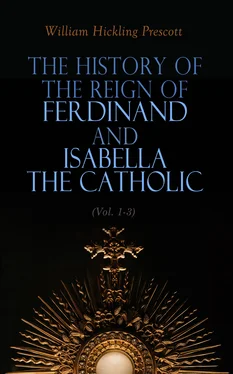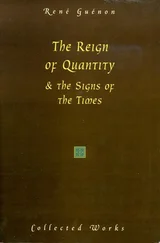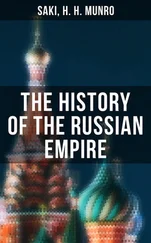[10] Corónica General, part. 3, fol. 54.
[11] According to Morales, (Corónica, lib. 13, cap. 57,) this took place about 850.
[12] Toledo was not reconquered until 1085; Lisbon, in 1147.
[13] The archbishops of Toledo, whose revenues and retinues far exceeded those of the other ecclesiastics, were particularly conspicuous in these holy wars. Mariana, speaking of one of these belligerent prelates, considers it worthy of encomium, that "it is not easy to decide whether he was most conspicuous for his good government in peace, or his conduct and valor in war." Hist. de España, tom. ii. p. 14.
[14] The first occasion, on which the military apostle condescended to reveal himself to the Leonese, was the memorable day of Clavijo, AD 844, when 70,000 infidels fell on the field. From that time, the name of St. Jago became the battle-cry of the Spaniards. The truth of the story is attested by a contemporary charter of Ramiro I. to the church of the saint, granting it an annual tribute of corn and wine from the towns in his dominions, and a knight's portion of the spoils of every victory over the Mussulmans. The privilegio del voto , as it is called, is given at length by Florez in his Collection, (España Sagrada, tom. xix. p. 329,) and is unhesitatingly cited by most of the Spanish historians, as Garibay, Mariana, Morales, and others.—More sharp-sighted critics discover, in its anachronisms, and other palpable blunders, ample evidence of its forgery. (Mondejar, Advertencies &, la Historia de Mariana (Valencia, 1746,) no. 157—Masdeu, Historia Crítica de España, y de la Cultura Española, (Madrid, 1783–1805,) tom. xvi. supl. 18.) The canons of Compostella, however, seem to have found their account in it, as the tribute of good cheer, which it imposed, continued to be paid by some of the Castilian towns, according to Mariana, in his day. Hist. de España, tom. i. p. 416.
[15] French, Flemish, Italian, and English volunteers, led by men of distinguished rank, are recorded by the Spanish writers to have been present at the sieges of Toledo, Lisbon, Algeziras, and various others. More than sixty, or, as some accounts state, a hundred thousand, joined the army before the battle of Navas de Tolosa; a round exaggeration, which, however, implies the great number of such auxiliaries. (Garibay, Compendio Historial de las Chrónicas de España, (Barcelona, 1628,) lib. 12, cap. 33.) The crusades in Spain were as rational enterprises, as those in the East were vain and chimerical. Pope Pascal II. acted like a man of sense, when he sent back certain Spanish adventurers, who had embarked in the wars of Palestine, telling them that "the cause of religion could be much better served by them at home."
[16] See Heeren, Politics of Ancient Greece, translated by Bancroft, chap. 7.
[17] The oldest manuscript extant of this poem, (still preserved at Bivar, the hero's birth-place,) bears the date of 1207, or at latest 1307, for there is some obscurity in the writing. Its learned editor, Sanchez, has been led by the peculiarities of its orthography, metre, and idiom, to refer its composition to as early a date as 1153. (Coleccion de Poesías Castellanas anteriores al Siglo XV. (Madrid 1779–90,) tom. i. p. 223.)
Some of the late Spanish antiquaries have manifested a skepticism in relation to the "Cid," truly alarming. A volume was published at Madrid, in 1792, by Risco, under the title of "Castilla, o Historia de Rodrigo Diaz," etc., which the worthy father ushered into the world with much solemnity, as a transcript of an original manuscript coeval with the time of the "Cid," and fortunately discovered by him in an obscure corner of some Leonese monastery. (Prólogo). Masdeu, in an analysis of this precious document, has been led to scrutinize the grounds on which the reputed achievements of the "Cid" have rested from time immemorial, and concludes with the startling assertion, that "of Rodrigo Diaz, el Campeador, we absolutely know nothing with any degree of probability, not even his existence!" (Hist. Crítica, tom. xx. p. 370.) There are probably few of his countrymen, that will thus coolly acquiesce in the annihilation of their favorite hero, whose exploits have been the burden of chronicle, as well as romance, from the twelfth century down to the present day.
They may find a warrant for their fond credulity, in the dispassionate judgment of one of the greatest of modern historians, John Muller, who, so far from doubting the existence of the Campeador, has succeeded, in his own opinion at least, in clearing from his history the "mists of fable and extravagance," in which it has been shrouded. See his Life of the Cid, appended to Escobar's "Romancero," edited by the learned and estimable Dr. Julius, of Berlin. Frankfort, 1828.
[18] A modern minstrel inveighs loudly against this charity of his ancestors, who devoted their "cantos de cigarra," to the glorification of this "Moorish rabble," instead of celebrating the prowess of the Cid, Bernardo, and other worthies of their own nation. His discourtesy, however, is well rebuked by a more generous brother of the craft.
"No es culpa si de los Moros los valientes hechos cantan, pues tanto mas resplandecen nuestras celebres hazañas; que el encarecer los hechos del vencido en la batalla, engrandece al vencedor, aunque no hablen de el palabra."
Duran, Romancero de Romances Moriscos, (Madrid, 1828.) p. 227.
[19] When the empress queen of Alfonso VII. was besieged in the castle of Azeca, in 1139, she reproached the Moslem cavaliers for their want of courtesy and courage in attacking a fortress defended by a female. They acknowledged the justice of the rebuke, and only requested that she would condescend to show herself to them from her palace; when the Moorish chivalry, after paying their obeisance to her in the most respectful manner, instantly raised the siege, and departed. (Ferreras, Histoire Générale d'Espagne, traduite par d'Hermilly, (Paris, 1742–51.) tom. in. p. 410.) It was a frequent occurrence to restore a noble captive to liberty without ransom, and even with costly presents. Thus Alfonso XI. sent back to their father two daughters of a Moorish prince, who formed part of the spoils of the battle of Tarifa. (Mariana, Hist. die España, tom. ii. p. 32.) When this same Castilian sovereign, after a career of almost uninterrupted victory over the Moslems, died of the plague before Gibraltar, in 1350, the knights of Granada put on mourning for him, saying, that "he was a noble prince, and one that knew how to honor his enemies as well as his friends." Conde, Domination de los Arabes, tom. iii. p. 149.
[20] One of the most extraordinary achievements, in this way, was that of the grand master of Alcantara, in 1394, who, after ineffectually challenging the king of Granada to meet him in single combat, or with a force double that of his own, marched boldly up to the gates of his capital, where he was assailed by such an overwhelming host, that he with all his little band perished on the field. (Mariana, Hist. de España, lib. 19, cap. 3.) It was over this worthy compeer of Don Quixote that the epitaph was inscribed, "Here lies one who never knew fear," which led Charles V. to remark to one of his courtiers, that "the good knight could never have tried to snuff a candle with his fingers."
[21] This singular fact, of the existence of an Arabic military order, is recorded by Conde. (Dominacion de los Arabes, tom. i. p. 619, note.) The brethren were distinguished for the simplicity of their attire, and their austere and frugal habits. They were stationed on the Moorish marches, and were bound by a vow of perpetual war against the Christian infidel. As their existence is traced as far back as 1030, they may possibly have suggested the organization of similar institutions in Christendom, which they preceded by a century at least. The loyal historians of the Spanish military orders, it is true, would carry that of St. Jago as far back as the time of Ramiro I., in the ninth century; (Caro de Torres, Historia de las Ordenes Militares de Santiago, Calatrava, y Alcantara, (Madrid, 1629,) fol. 2.—Rades y Andrada, Chrónica de las Tres Ordenes y Cavallerías, (Toledo, 1572,) fol. 4,) but less prejudiced critics, as Zurita and Mariana, are content with dating it from the papal bull of Alexander III., 1175.
Читать дальше












